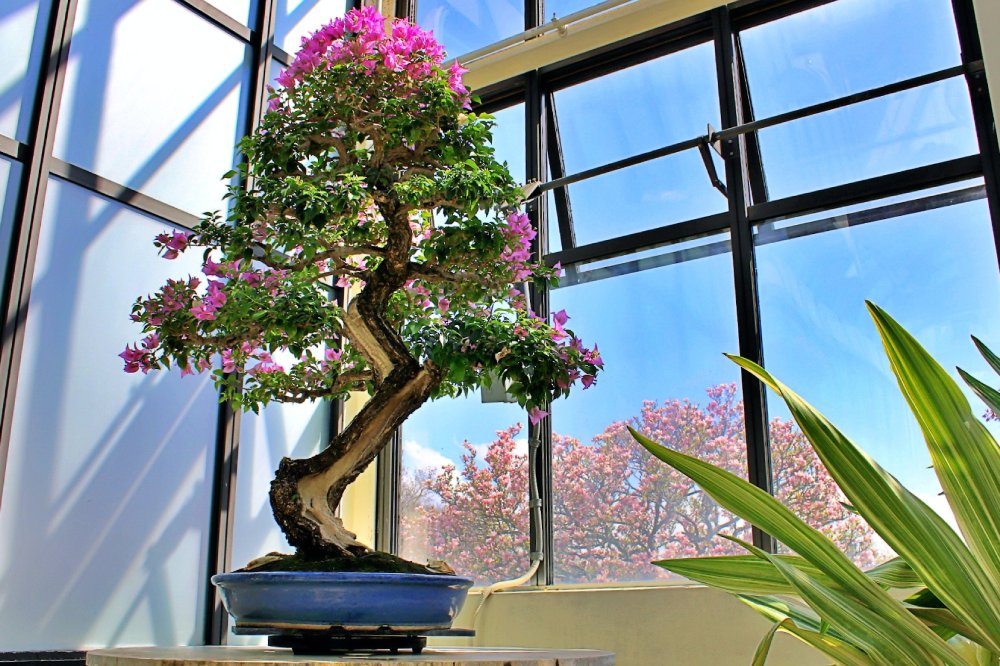Culture
 Photo courtesy of the U.S. National Arboretum.
Photo courtesy of the U.S. National Arboretum.
Off the Mall: The National Bonsai + Penjing Museum
May 4, 2023 @ 12:00pm
This bimonthly series highlights lesser-known museums in and around D.C.
Located on the grounds of the U.S. National Arboretum, the National Bonsai & Penjing Museum holds claim as the world’s “first and finest” bonsai museum, boasting over 200 tiny trees with prestigious pedigrees.
The museum began with a Japanese gift of 53 bonsai for America’s 1976 bicentennial — originally one for each state, plus a bonus three. A private Pan Am jet was chartered to transport these national treasures — including a red pine from Japan’s Imperial collection in training since 1795 — to the U.S. as a diplomatic token of friendship and forgiveness.
The museum has since evolved into an artfully designed labyrinth of indoor and outdoor pavilions and gardens showcasing the art of bonsai and its ancient Chinese predecessor, Penjing — living, wizened sculptures continuously shaped by the hands of time and humans.
The 63 trees in the museum’s North American collection includes native species from across the continent, from bald cypress from the swamps of Louisiana to craggy juniper from the deserts of California. Many of these trees were trained under the tutelage of John Naka, the Japanese American godfather of bonsai.
The museum also houses an exquisite collection of “viewing stones,” which are visually striking stones recalling aspects of nature such as a waterfall or mountain range. The museum’s 105 stones hail from around the world, from Italy to Zaire. Like the museum’s bonsai, many of these viewing stones were gifts of diplomacy, such as Mums in the Moonlight, a Japanese chrysanthemum-patterned rock given to President Gerald Ford and eventually regifted to the museum.
From May 5-7, the museum will host the Potomac Bonsai Association (PBA)’s Annual Bonsai Festival, featuring bonsai demonstrations and workshops, a juried exhibit of PBA bonsai and vendors selling bonsai and related supplies. The following Saturday, May 13, the museum will celebrate World Bonsai Day with free docent-led tours, a children’s activity table and the kickoff of a sold-out series of workshops on chrysanthemum bonsai.
Who It’s For:
Tree hugging apartment dwellers, Asian art and history buffs, pet rock collectors, meditative types
Don’t Miss:
- The museum’s most famous bonsai is also its oldest, a Japanese white pine dating back four centuries. What’s most notable about the tree is that it survived America’s 1945 atomic bombing, astonishingly having been sheltered by a tall wall in a Hiroshima bonsai nursery.
- Also look out for Goshin, an acclaimed bonsai created by Japanese-American bonsai master John Naka, who was a driving force in the U.S. spread of bonsai appreciation. This stately arrangement of eleven shaggy-barked Foemina junipers, the first of which Naka began training in 1948, represent his eleven grandchildren.
- The museum’s Penjing collection features the distinctive Chinese style of landscape displays, with dwarfed trees setting the scene for a living diorama dotted with tiny figurines.
- Check out the Satsuki azaleas covered in pink starry blooms this month, then visit their full-grown cousins in the Arboretum’s nearby Azalea collections.
Fun Facts:
- You’ve been pronouncing bonsai wrong your whole life. Say it with me: bone-zi.
- The Chinese style of Penjing predates the Japanese art form, tracing back to the Tsin Dynasty in China (265-420 A.D.).
- Bonsai branches are trained with wires until they are coaxed into their desired shapes, while the roots are clipped to stunt their growth.
- President Richard Nixon loved bonsai, having received a few Penjing while visiting China, and he kept one at his desk in the Oval Office. None are known to have survived.
Tips:
Look for numbers on display to call for an audio tour via cell phone. The “in training since…” placards indicate how long a given tree in the collection has been continuously maintained. Come back in autumn for the museum’s fall foliage exhibit, featuring bonsai from the collections whose leaves change color or bear fruit.
The National Bonsai & Penjing Museum is free and open every day from 10 a.m. to 4 p.m. Free parking on site. Visit their online exhibits and learn more about their programs here.
National Bonsai & Penjing Museum: 3501 New York Ave. NE, DC; usna.usda.gov // @nbfbonsai
Want to learn more about the many ways to experience life in D.C.? Join the District Fray community, where you’ll gain first access to exclusive events in the District. Become a member and support local journalism today.







